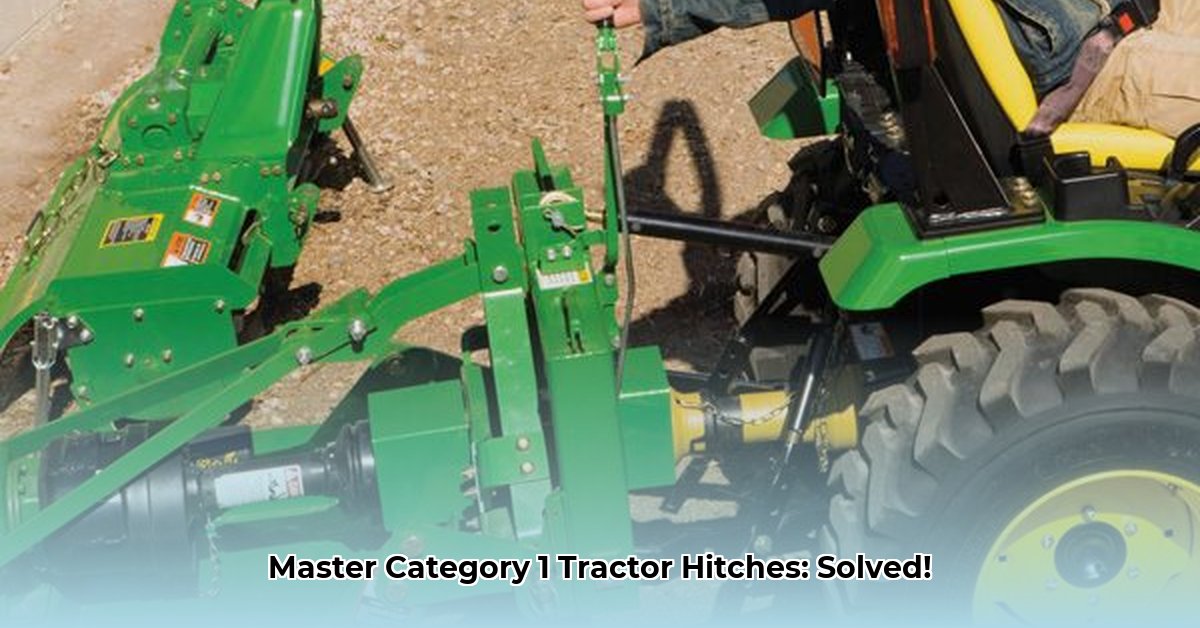
Understanding Category 1 Hitches: Full vs. Limited
Choosing the right three-point hitch for your Category 1 tractor is crucial for safe and efficient operation. A three-point hitch connects your tractor to implements like plows and tillers. Category 1 hitches are common on smaller tractors, but there's a distinction: "full" and "limited" Category 1. Both use the same pin sizes but differ in construction and lift capacity. Think of it like comparing a heavy-duty pickup truck to a smaller compact car – both can carry things, but their capabilities differ significantly. For alternative hitches, explore options like lawn tractor receiver hitches.
Here's a comparison:
| Feature | Full Category 1 | Limited Category 1 |
|---|---|---|
| Lower Link Pin Diameter (in) | 1.125 | 1.125 (but less robust construction) |
| Upper Link Pin Diameter (in) | 0.9375 | 0.9375 (but less robust construction) |
| Lift Capacity (lbs) | Varies greatly (check your manual!) | Significantly less than Full Cat 1 |
| Typical Tractor HP Range | Generally above 25 HP | Generally below 25 HP |
Important Note: Always consult your tractor's owner's manual for precise specifications. The manual provides critical information regarding your specific tractor's capabilities and limitations. Ignoring this information can lead to equipment damage or injury.
Matching Tractor and Implements: A Perfect Pair
Matching your tractor's capabilities to your implements is paramount. Using an implement too heavy for your hitch risks damaging your tractor, and an implement too light may not perform its task effectively. This section provides a step-by-step guide to ensure compatibility.
Step-by-Step Guide:
- Consult your tractor's manual: This details your tractor's maximum lift capacity. This step is non-negotiable.
- Determine implement weight: Accurately weigh your implement. Agricultural supply stores often have scales suitable for this purpose.
- Compare weights: Ensure the implement's weight is well below your tractor's maximum lift capacity. A safety margin is advisable.
- Consider the task: Heavy-duty tasks require more lifting power than light tasks. Select an implement and hitch combination appropriate for the work.
Choosing the right implement ensures safe and efficient operation. Always err on the side of caution; having extra lift capacity is better than insufficient capacity.
Troubleshooting and Safety: Best Practices
Even with careful selection, problems can arise. This section lists common issues and critical safety precautions.
Common Problems and Solutions:
- Broken or worn hitch pins: Regularly inspect and replace damaged pins immediately. This is critical for safe operation.
- Implement instability: This suggests improper weight distribution. Adjust the implement's position for better balance.
- Insufficient lift height: The implement may be too heavy for the hitch. Re-evaluate your implement selection and consult your tractor's manual.
Critical Safety Precautions:
- Always lower and secure: Always lower and fully secure the implement before engaging the PTO (Power Take-Off). Failure to do this can cause serious injury.
- Never work underneath a raised implement: Use safety stands or blocks to securely support lowered implements.
- Keep clear of moving parts: Maintain a safe distance from moving parts to prevent injury.
- Regular lubrication: Lubricate moving parts regularly to prevent seizing and extend the lifespan of your hitch. This simple step dramatically reduces maintenance challenges.
Selecting the Right Hitch: Your Step-by-Step Checklist
- Determine your tractor's horsepower (HP): Consult your tractor's manual.
- Identify implement weight: Weigh your implement accurately (using a suitable scale).
- Consult your tractor's manual for hitch specifications: This step is crucial for safe operation.
- Compare tractor capabilities to implement needs: Match your hitch capacity to the implement and the job.
- Select "full" or "limited" Category 1 hitch: Choose the appropriate hitch for the task.
- Prioritize safety: Regular maintenance and careful operation are essential for safe use and long equipment life. A little preventive maintenance can save a lot of time and headaches down the road.
How to Choose the Right 3-Point Hitch Category for My Tractor Based on Implement Weight
Key Takeaways:
- Understanding 3-point hitch categories prevents equipment damage and injury.
- Category 1 hitches are standard on many smaller tractors.
- Matching implement weight to hitch category optimizes performance and safety.
- Improper matching can result in equipment failure or serious injury.
- Accurate implement weighing is critical for safe operation.
Understanding Category 1 Hitches: A Quick Reference
| Specification | Full Category 1 | Limited Category 1 |
|---|---|---|
| Lower Link Pin Diameter (inches) | 1 1/8 | 1 1/8 |
| Upper Link Pin Diameter (inches) | 7/8 | 7/8 |
| Lift Arm Spacing (inches) | ~20-28 | ~20-28 |
| Typical Lift Capacity (lbs) | Varies by tractor | Varies by tractor, generally lower |
Remember: These are approximations. Consult your tractor's manual for precise specifications.
Matching Tractor and Implement: A Detailed Guide
Step 1: Consult your tractor's manual. Your manual specifies your tractor's hitch category and maximum lift capacity. This is fundamental.
Step 2: Measure implement weight. Weigh your implement accurately using an appropriate scale.
Step 3: Compare weights. Ensure your implement’s weight is significantly less than the tractor's maximum lift capacity. A safety buffer is crucial.
Step 4: Consider adapters. Adapters allow using smaller category implements on larger hitches, but they reduce strength and add potential failure points.